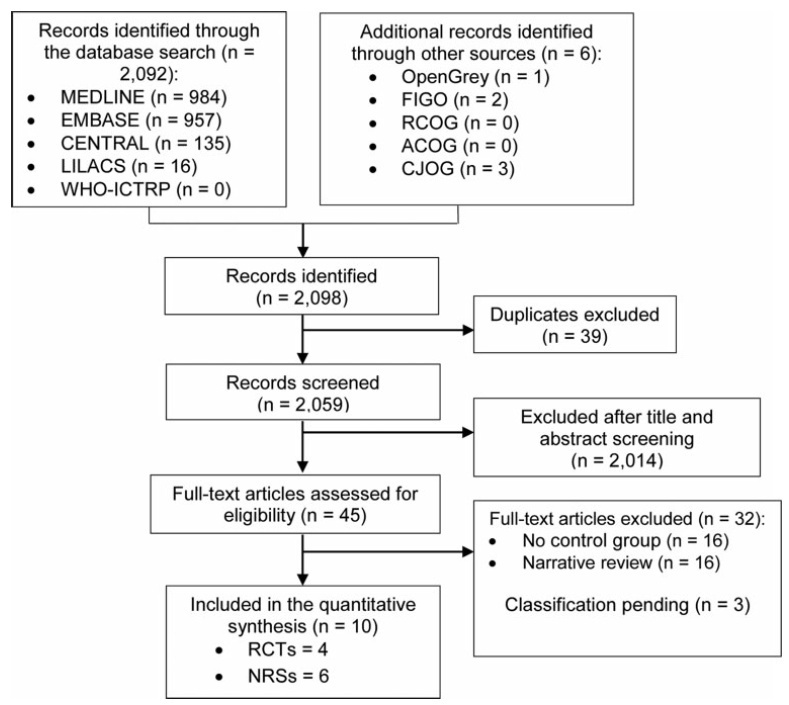Summary
Revista Brasileira de Ginecologia e Obstetrícia. 2021;43(8):627-637
To compare the effects of expectant versus interventionist care in the management of pregnant women with severe preeclampsia remote from term.
An electronic search was conducted in the Medical Literature Analysis and Retrieval System Online (MEDLINE), Excerpta Medica Database (EMBASE), Cochrane Central Register of Controlled Trials (CENTRAL), Latin American and Caribbean Health Sciences Literature (LILACS, for its Spanish acronym), World Health Organization’s International Clinical Trials Registry Platform (WHO-ICTRP), and Open- Grey databases. The International Federation of Gynecology and Obstetrics (FIGO, for its French acronym), Royal College of Obstetricians and Gynaecologists (RCOG), American College of Obstetricians and Gynecologists (ACOG), and Colombian Journal of Obstetrics and Gynecology (CJOG) websites were searched for conference proceedings, without language restrictions, up to March 25, 2020.
Randomized clinical trials (RCTs), and non-randomized controlled studies (NRSs) were included. The Grading of Recommendations, Assessment, Development and Evaluation (GRADE) approach was used to evaluate the quality of the evidence.
Studies were independently assessed for inclusion criteria, data extraction, and risk of bias. Disagreements were resolved by consensus.
Four RCTs and six NRS were included. Low-quality evidence from the RCTs showed that expectant care may result in a lower incidence of appearance, pulse, grimace, activity, and respiration (Apgar) scores<7 at 5 minutes (risk ratio [RR]: 0.48; 95% confidence interval [95%CI]: 0.23%to 0.99) and a higher average birth weight (mean difference [MD]: 254.7 g; 95%CI: 98.5 g to 410.9 g). Very low quality evidence from the NRSs suggested that expectant care might decrease the rates of neonatal death (RR: 0.42; 95%CI 0.22 to 0.80), hyalinemembrane disease (RR: 0.59; 95%CI: 0.40 to 0.87), and admission to neonatal care (RR: 0.73; 95%CI: 0.54 to 0.99). Nomaternal or fetal differences were found for other perinatal outcomes.
Compared with interventionist management, expectant care may improve neonatal outcomes without increasing maternal morbidity and mortality.

Summary
Revista Brasileira de Ginecologia e Obstetrícia. 1998;20(5):253-260
DOI 10.1590/S0100-72031998000500004
Objectives: To determine sensitivity, specificity, positive and negative predictive values of the shake test (Clements) for evaluation of fetal lung maturation in preeclamptic patients. Methods: A prospective study for validation of a diagnostic method was conducted enrolling 163 preeclamptic patients (gestational age between 28-34 weeks) admitted at CAM-IMIP with indication for fetal maturity testing. Preeclampsia diagnosis and classification followed criteria of the National High Blood Pressure Working Group, 1990. Clements' test was performed in three tubes and positive, negative or intermediate results were considered for analysis (related to presence or absence of fetal lung maturity). Accuracy parameters were calculated considering actual incidence of hyaline membrane disease (positive maturity = absent disease) after birth. Hyaline membrane disease was defined by criteria of CLAP, 1978. Statistical analysis was performed using c² test (Epi-Info 6.04b) with a 5% significance level. Results: Intermediate results were considered alternately as positive or negative for analysis. When considered positive, sensitivity was 87.9% and specificity 74.5% with positive and negative predictive values of 8.9.4% and 71.4% respectively - efficiency was 84%. When intermediate results were evaluated as negative, sensitivity decreased to 62% and specificity raised to 89.4% and positive and negative predictive values were 93.5% and 51.2% respectively (efficiency = 70%). False-positive results were rare and usually related to neonatal hypoxia: only 5 (6.5%) of 77 neonates with previous positive Clements had hyaline membrane disease. Nevertheless, false negatives were frequent: almost 40% for negative/intermediate results. Conclusions: Despite its limitations, Clements' test remains a good method for investigation of fetal lung maturation in preeclamptic patients since false positive results are unusual. However sensitivity is low and results have be cautiously analyzed because of elevated rate of false negative results. A good policy is to complement fetal maturity investigation with other tests if a negative result is determined, specially in severe cases when confirmed maturity represents indication for interruption of pregnancy.